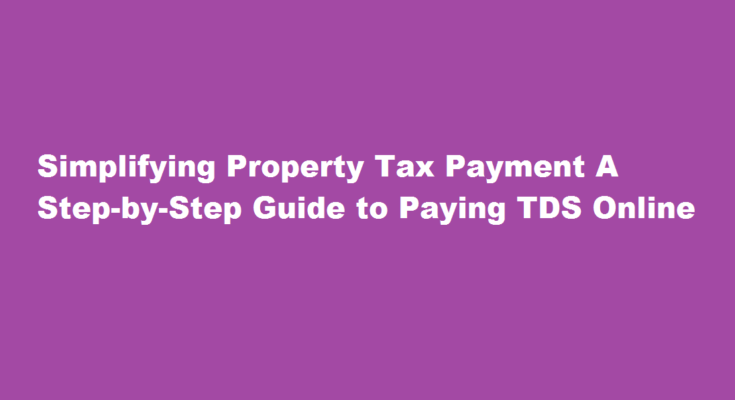Introduction
Paying TDS (Tax Deducted at Source) on property transactions is an essential obligation for property owners in many countries. With the advancement of technology, governments have made it easier to fulfill this responsibility by enabling online payment options. In this article, we will provide a comprehensive step-by-step guide on how to pay TDS on property online, ensuring a smooth and hassle-free process.
Understand TDS on Property
Tax Deducted at Source (TDS) is a mechanism employed by governments to collect taxes at the source of income generation. In the context of property transactions, TDS is levied on the purchase or sale of property exceeding a certain threshold. The buyer of the property is responsible for deducting a specified percentage of the transaction value and remitting it to the government.
Gather Required Information
Before initiating the online payment process, it’s crucial to gather all the necessary information. This includes the PAN (Permanent Account Number) of the buyer and seller, the amount of TDS to be deducted, and the relevant challan or form for payment.
Access the Government Portal
Most countries have a dedicated government portal for online tax payments. Locate the official website of the tax department or revenue authority responsible for TDS on property transactions. Create an account if you don’t have one already.
Fill in the Required Details
Once logged in, navigate to the section related to property tax payments or TDS. Enter the required details such as PAN, property details, transaction value, and TDS amount to be deducted. Ensure accuracy in providing these details to avoid any discrepancies.
Generate the Challan
After submitting the necessary information, the system will generate a challan or acknowledgement. This challan contains a unique identification number and details of the payment. Download or print the challan for your records.
Choose the Payment Method
The government portal will provide various payment options to settle the TDS amount. These can include online banking, credit/debit cards, net banking, or electronic wallets. Select the most convenient payment method and proceed with the transaction.
Make the Payment
Follow the instructions provided by the portal to make the payment. Enter the required payment details and confirm the transaction. Keep a record of the transaction ID or reference number for future reference.
Verify the Payment Status
After completing the payment, verify the status of your TDS payment. Most government portals offer a facility to check the status of recent transactions. If the payment is successful, the status will reflect as “paid” or “completed.”
FREQUENTLY ASKED QUESTIONS
How can I make payment of 26QB after generating Acknowledgement?
Submit duly-filled form and confirm. A new page appears with a unique acknowledgement number that you should save for future reference. On that page itself, click on “Print Form 26QB” to print the 26QB form. Then click on “Submit to the bank” to make the required payment online through net banking.
What is the time limit for payment of 26QB?
Every person responsible for deduction of tax under section 194-IA shall furnish to the Director General of Income-tax (System) or the person authorized by him a challan-cum-statement in Form No. 26QB electronically within 30 days from the end of the month in which the deduction is made.
How long is 26QB challan valid?
Pay online with net banking using the e-tax payment option on the TIN NSDL website. Generate Form 26QB with a unique acknowledgement number and visit your bank with this form to make the payment. The form 26QB with acknowledgement number is valid for 10 days.
Conclusion
Paying TDS on property transactions is now easier than ever with the availability of online payment options. By following this step-by-step guide, property owners can fulfill their tax obligations conveniently and efficiently. Remember to keep all payment receipts and documents for future reference and to ensure compliance with tax regulations.
Read Also : Mastering The Art of Pasting on Your Laptop A Step-by-Step Guide



